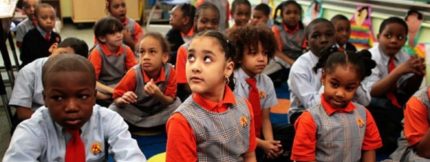
In recent years the number of students coming from low-income backgrounds has exploded, officially reaching a tally of more than half of the students across the nation living close to or beneath the poverty line.
After analyzing data collected from the National Center for Education Statistics, the Southern Education Foundation (SEF) discovered that 51 percent of public school students at the K-12 level qualified for federal programs that provide free lunch to children living close to or in poverty.
“In 40 of the 50 states, low income students comprised no less than 40 percent of all public schoolchildren,” the SEF reported. “In 21 states, children eligible for free or reduced-price lunches were a majority of the students in 2013.”
It’s a shocking change from 1989 when the nation reportedly had less than a third of its public school students living in or close to poverty.
The numbers are proof that in America, middle and lower class citizens are left struggling to fight off poverty in the midst of an unstable economy, while the rich continue to grow richer.
“A lot of people at the top are doing much better, but the people at the bottom are not doing better at all,” Michael A. Rebell of the Campaign for Educational Equity at Columbia’s Teachers College told the Washington Post. “Those are the people who have the most children and send their children to public school.”
The numbers also shine a light on the importance of boosting educational equality in America.
With the majority of students in the U.S. coming from low-income backgrounds, that means many families are unable to put their child in a private school that may be performing better or move to a district with better resources.
Currently, many Black parents can attest to the fact that putting their child in a school with better test scores can often mean placing the child in a predominantly white school composed of wealthier families, which may be a less than hospitable environment for the child.
Critics of boosting school choice, especially in urban communities, point to a new study from the Education Research Alliance for New Orleans suggesting low-income parents don’t pick the best schools for their children even when they are given a choice.
In New Orleans, nine of out 10 school children attend charter schools, which means the city’s school system thrives on the idea of parents having a choice in where their children go to school. The recent study revealed that in many cases, parents actually didn’t put their children in the school that presented the highest test scores.
Other factors such as location, extracurricular activities and extended school hours trumped test scores for many parents.
But these numbers do not necessarily mean parents weren’t concerned about the quality of their child’s education, rather that there are many factors that parents consider instead of strictly looking at test scores.
For instance, having extracurricular activities has been proven to boost a student’s performance in the classroom—a fact that parents can sense instinctively, knowing how important it is for children to have other activities, such as music and sports.
A study by the U.S. Department of Education revealed that students who participated in extracurricular activities that they enjoyed were actually three times more likely than the average student to have a grade point average of 3.0 or higher.
As for focusing on extended school hours and location, critics fail to consider the importance of transportation issues and work schedules for parents.
As one NPR reader explained, distance will always be a key determining factor for many working parents.

Such concerns reveal that the importance of school choice means parents will decide which school is best for the child based on more factors than just overall test scores, as these schools may not offer the best extracurricular activities, be in a desirable location, offer after school programs or boast an environment that is inclusive and comfortable for students of color.
When those factors are considered, it seems like the real question shouldn’t be “why aren’t parents picking schools with the best test scores,” but instead “why is it that in America, a land that boasts equality and opportunity, parents forced to pick between having the most resources available to their child in school or keeping their jobs?”
In other words, it shouldn’t be so rare to see adequate resources and a diverse student body present in the same school.


